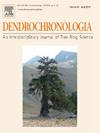Climate and biological factors co-regulate the drought resilience of Pinus tabulaeformis
IF 2.7
3区 农林科学
Q1 FORESTRY
引用次数: 0
Abstract
Severe drought can threaten the structure and function of forest ecosystems by profoundly altering plant growth and mortality. Identifying the drivers influencing drought resilience is essential for understanding the global warming effect on the forest ecosystem. However, the direct and indirect impacts of multiple climate and biological factors on drought resilience remain unquantified, and a potential mechanistic pathway remains unexplored. Here, we aimed to quantify the drought resistance, recovery, and resilience of Pinus tabulaeformis using the basal area increment. We showed that the Palmer Drought Severity Index had a significant direct positive impact on resistance, negative impact on recovery, but non-significant impact on resilience. Tree age and pre-drought basal area increments (preBAI) had significant direct negative effects on recovery and resilience, while only preBAI significantly affected resistance. Additionally, the competition index had a relatively minor direct effect on resistance, recovery, and resilience but exerted a significant negative influence on recovery by limiting the diameter at breast height (DBH). This research suggests that climate and biological factors co-regulate the drought resilience of Pinus tabulaeformis in this region. Resistance and recovery are primarily constrained by PDSI, while resilience mainly depends on individual tree characteristics. Biotic factors and climate directly affect resilience but competition restricts recovery by mediating DBH. The findings emphasize the importance of considering both biological and abiotic factors in forest management strategies to enhance ecosystem stability under future climate change.
气候和生物因子共同调控油松的抗旱能力
严重干旱可以通过深刻地改变植物的生长和死亡来威胁森林生态系统的结构和功能。确定影响抗旱能力的驱动因素对于了解全球变暖对森林生态系统的影响至关重要。然而,多种气候和生物因子对干旱恢复力的直接和间接影响尚未量化,潜在的机制途径尚未探索。本文旨在利用基底面积增量量化油松的抗旱性、恢复力和恢复力。结果表明,帕尔默干旱严重指数对抗旱性有显著的直接正影响,对恢复有显著的负影响,但对恢复力的影响不显著。树龄和干旱前基底面积增量(preBAI)对恢复力和恢复力有显著的直接负影响,而只有preBAI对抗逆性有显著影响。此外,竞争指数对抗性、恢复力和恢复力的直接影响相对较小,但通过限制胸径对恢复力产生显著的负向影响。研究表明,气候和生物因素共同调控了该地区油松的抗旱性。抗性和恢复主要受PDSI的制约,而恢复力主要取决于树的个体特征。生物因子和气候直接影响恢复力,但竞争通过调节胸径h限制恢复。研究结果强调了在森林管理策略中考虑生物和非生物因素以增强未来气候变化下生态系统稳定性的重要性。
本文章由计算机程序翻译,如有差异,请以英文原文为准。
求助全文
约1分钟内获得全文
求助全文
来源期刊

Dendrochronologia
FORESTRY-GEOGRAPHY, PHYSICAL
CiteScore
5.50
自引率
13.30%
发文量
82
审稿时长
22.8 weeks
期刊介绍:
Dendrochronologia is a peer-reviewed international scholarly journal that presents high-quality research related to growth rings of woody plants, i.e., trees and shrubs, and the application of tree-ring studies.
The areas covered by the journal include, but are not limited to:
Archaeology
Botany
Climatology
Ecology
Forestry
Geology
Hydrology
Original research articles, reviews, communications, technical notes and personal notes are considered for publication.
 求助内容:
求助内容: 应助结果提醒方式:
应助结果提醒方式:


